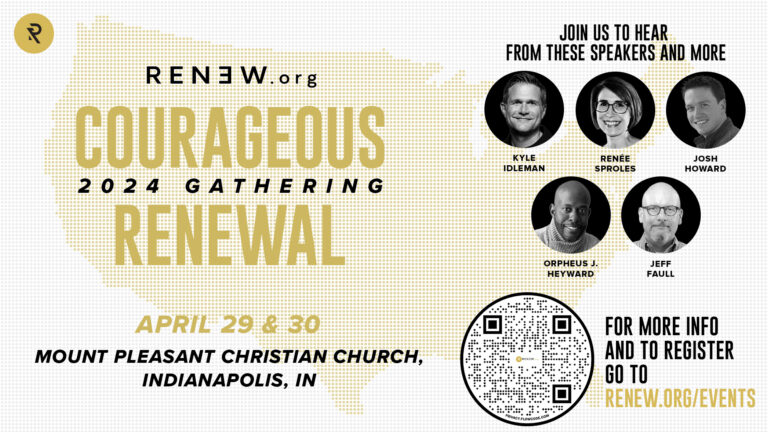Who doesn’t love a good story? John Mark Hicks’s new book, Women Serving God: My Journey in Understanding Their Story in the Bible, is full of them. We find the story of Hicks’s journey from rigid patriarchy to egalitarianism, the stories of church history and its various positions on the subject of women in ministry, the stories of women in the Bible, the overarching story of Scripture, and ending with stories from three women. Hicks’s book tells a lot of stories.
As Christian musician and novelist Andrew Peterson says, “If you want someone to hear the truth, you should tell them the truth. But if you want someone to love the truth, you should tell them a story.”
The problem is, what if the story isn’t true? Or only partly true? Or what if it’s influenced by other stories from our culture that are not true at all?
Inviting the reader to listen to all the varying stories to gain understanding, we Renew.org contributors have done just that, and we believe that Hicks’s story fails to understand the truth about gender as revealed in Scripture.
Thus begins a series of questions and answers, by Renew.org contributors, engaging with these stories.
In addition to Hicks’s Women Serving God, we will also engage with an influential book that comes to the same conclusions as Hicks’s: Scot McKnight’s Blue Parakeet: Rethinking How You Read the Bible.
This series of posts are intended to be a Q&A-type companion to Renee Sproles’s book, On Gender: What the Bible Says About Men and Women and Why it Matters. If you want a single book that presents an alternative point of view to Hicks and McKnight, we recommend that book.
This is the first of several long posts on these topics. They are long because we must get into the substance of the arguments these men and others like them make on what the Bible teaches. Sound bites will not work. We need a more in-depth examination. Thanks for making the time to read this first one.
Here is a summary of Renew.org’s position and what we will defend in these articles:
We believe both men and women were created by God to equally reflect, in gendered ways, the nature and character of God in the world. In marriage, husbands and wives are to submit to one another, yet there are gender specific expressions: husbands model themselves in relationship with their wives after Jesus’ sacrificial love for the church and wives model themselves in relationship with their husbands after the church’s willingness to follow Jesus. In the church, men and women serve as partners in the use of their gifts in ministry, while seeking to uphold New Testament norms which teach that the lead teacher/preacher role in the gathered church and the elder/overseer role are for qualified men. The vision of the Bible is an equal partnership of men and women in creation, in marriage, in salvation, in the gifts of the Spirit and in the ministries of the church but exercised in ways that honor gender as described in the Bible.
We’ll begin with an introduction to the methods and tools Hicks and McKnight use in their books. In subsequent posts, we will move to key passages addressed in the books: most notably, 1 Corinthians 11, 1 Corinthians 14, and 1 Timothy 2. Then we’ll conclude with some final thoughts, especially a “so what” section, telling what we believe is a true and accurate story of gender in the Bible and women in church. In other words, can we simply agree to disagree on this sticky topic? Or are the stakes higher?
Q: What are the three positions described in Women in the Church?
Renée: Hicks describes three camps or interpretations regarding the roles of men and women in the church: no participation, limited participation, and full participation. Let’s look at each.
No participation: “A strong principle of male leadership means women should not have any leading voices or presence in the assembly. This not only excludes reading Scripture, preaching, or presiding at the table but also making announcements, audibly requesting prayers, voicing a prayer, asking questions, passing the communion trays standing, or testifying about an answered prayer” (17).
This is rigid patriarchy. Renew.org disagrees with this position as it replaces the teaching of Scripture with the traditions of men. It is over-reaching and ignores clear passages where women pray and prophesy (see 1 Corinthians 11). We do not support this position.
Limited participation: The headship of males is to be understood in terms of responsibility more than authority. “Men are not empowered to order women to conform as much as men are accountable for the spiritual health of the community. Men, as Christlike ‘heads,’ should serve, empower, and sacrifice for women. . . . Male headship is a key principle, but it does not exclude women from all leadership function in the assembly” (17-18).
This is the soft “complementarian” position. Renew supports this position, allowing for broad participation in the church by women, with the senior minister/pastor and elder roles reserved for men.
Full participation: “This position opens all functions in the assembly to women according to their gifts while giving due attention to cultural sensitivity and deference to local customs or traditions for the sake of the gospel (e.g. Christians in Iran). While some couch this primarily in the language of rights and justice, others frame it in the light of gifts and privileges. Some emphasize both.” Hicks calls the exclusion of women “a cultural scandal in the United States” (19).
This is an “egalitarian” position. Renew.org believes that just as rigid patriarchy overreaches in restricting women, egalitarianism overreaches in ignoring the gendered roles and order of men and women. Paul points to creation order, not culture or gifting, when directing men’s and women’s roles in church.
Q: At the heart of Hicks’s arguments are his hermeneutics and theology, but what do those terms mean, exactly?
Renée: Hermeneutics is how we interpret Scripture. Theology is taking those interpretations and making them fit together, like a puzzle, without setting aside any of the pieces or trimming them to make them fit. Thus, good hermeneutics makes for good theology. Bad hermeneutics makes for bad theology.
Renew.org exists because we believe good hermeneutics and theology matter.
Q: Are hermeneutics and theology just for nerds, professors, and preachers?
Renée: No. Every Christian uses hermeneutics to build a theology—a cohesive, coherent understanding of Scripture, whether they realize it or not. For most Christians, their practice is their theology. That’s why repentance and obedience are so powerful. These two disciplines take your theology from your mind and get them down into your heart, soul, and body.
The strong connection between practice and theology explains why many Christians get upset when something in their worship service or favorite ministry changes. Although they might not be able to articulate it, they get the feeling that we’re messing with their theology–their ability to make sense of the full revelation of Scripture–when we change a practice.
Q: Hicks presents two hermeneutical options: blueprint and theological. So, what’s the difference between them, and are these the only options?
Renée: The difference between blueprint and theological hermeneutics, as Hicks describes them, is basically a what’s the pattern question versus a what’s the point question. Blueprint hermeneutics seeks a “specific and exclusive blueprint” of explicit commandments, approved (binding) examples, and necessary inferences for things like how to conduct a worship assembly. Hicks goes to great lengths in explaining how he once used this hermeneutic to figure out, among other things, if girls could lead boys in chain prayers in his youth group.
Theological hermeneutics is where Hicks’s journey has taken him. Instead of searching for patterns, he now seeks to find the “theological point that is at work” in the text and the point that fits in the “story” of the Bible (69).
Hicks is right that each biblical command rests upon a theological truth—in legal language, statutes are intended to enforce precepts. But he wrongly assumes that we can easily separate the two—extracting a kernel of theological truth from a time-bound biblical command—for often, the command itself embodies the theology.
For example, baptism isn’t just a Jewish ritual temporarily embodied in first century baggage. We are not invited by Scripture to throw away the ritual baggage of water and cling rather to its theological “nugget” of salvation. The opposite is true: The form of baptism is tied to the meaning–as we are washed in water our sins are washed away (Acts 22:16), so that the theological truth and the individual command are intricately woven together. Stated differently, the biblical norm is integrally connected to the biblical meaning. Throw away one, and you throw away the other.
Furthermore, Hicks’s methodology is subjective.
Those who seek to separate “the baggage of culture” from “timeless theology” always end up suspiciously stripping away only the baggage that disagrees with their own cultural moment. Stripping away the teachings of Scripture on gender would only make sense in a culture that has already decided that egalitarianism must be promoted. Why must Western elite values always constitute the “theological kernel” excavated from texts that trouble university professors?
Renew.org exists because we believe good hermeneutics and theology matter.
Q: Are other options available in addition to blueprint and theology hermeneutics?
Renée: Blueprint and theological hermeneutics are not the only two ways to interpret Scripture and build a cohesive theology. Understanding and obeying Scripture isn’t limited to either finding commands to obey or finding a story. In my book, On Gender: What the Bible Says About Men and Women and Why it Matters, I outline a three-step process for hermeneutics that blends the best of these two approaches. I’ll add a fourth step here:
Principle #1: Figure out what Scripture meant to the original readers. Historical and cultural context matters when understanding Scripture.
Principle #2: Let the Bible explain itself. Scripture says things about itself that indicate the authors believe they are writing a coherent biblical theology. The New Testament regularly interprets the Old Testament, which will be very important to keep in mind here.
Principle #3: Figure out how I can obey it. Anytime I ask, “Did God really say…” to wriggle out of obedience, I actively participate in Adam and Eve’s sin, elevating my own will over God’s.
Principle #4: Look at the history of the church. Do you think we are the first generation to wrestle with these issues? Countless saints who have come before us also sought to understand and obey, and we would do well to listen to them.
Q: Taking his theological hermeneutic and putting it to work, Hicks believes that we can find the pervasive story of Scripture as one of new creation where the Spirit “actualizes new creation in the present” (116). Is this the story of Scripture?
Renée: To simplify, there have been two main positions or “stories” in evangelicalism the last hundred years. These are not mutually exclusive, but they can easily lead to very different visions of the Christian faith. Classical evangelicalism has emphasized personal salvation as the story of the Bible: Jesus came to save me from my sin, lead me to live a holy life, and prepare me for his second coming. This vision regularly looks back to Scripture to assure a faithful response to salvation.
After the work of such scholars as N. T. Wright, many other evangelicals have emphasized a broader vision of the kingdom of God, emphasizing a social focus on justice and human flourishing here and now. This story tends to look forward toward a vision of how this creation can be made to look more like heaven. One can see how these two visions can easily lead to very different interpretations of the Christian life.
Like many, I submit that it’s not either personal salvation or new creation; it’s both. Our personal salvation in Christ makes us perfect and calls us to a lifestyle of holiness (Hebrews 10:14). Yet the creation itself is also waiting to be set free from its bondage to corruption so that it can enjoy the freedom of the glory of God’s children (Romans 8:20-23). Focus too much on personal salvation and you can ignore a hurting world. Focus too much on new creation and you can neglect personal holiness.
Q: Hicks uses “trajectory” argument in his theological, “new creation” hermeneutic. What kind of trajectory does Hicks see and where does it lead us?
Renée: Hicks believes that “Scripture points us beyond its own circumstances and specific applications through seed texts (e.g., Galatians 3:28), paradigm shifts in the story (e.g., the pouring out of the Spirit on women in Acts 2), and the original vision of full mutuality in creation fulfilled in new creation (Genesis 1-2). The church is new creation.”
That is, commands or instructions are cultural with a theological nugget of truth inside them. Find that nugget, and you can apply it to your cultural moment. We all do it, Hicks argues, so why not just be honest about it and move on?
But how does one find these seed texts, paradigm shifts, and original vision of mutuality? Why is Galatians 3:28 a seed text and not Hebrews 6:1-3 or something else? Why is the paradigm shift primarily to “oneness” and not to citizenship in God’s Kingdom or something else? There is a great temptation for every generation to use the culture around us to go ahead and define things like equality and gender and then go looking in Scripture for what we’ve already predetermined.
The kingdom of God and “the perfect law that gives freedom” have been at odds with cultural norms throughout all of history.
For if culture is making something out of nothing, assigning meaning to things, then sinful humanity stamped with the image of God will get some things right and some things wrong. The right and wrong will be different from culture to culture, so Scripture will affirm different truths and contradict different lies in each one. Yet, this is why Scripture is so compelling, so eternal. It is able to teach, instruct, contradict, and correct all people in all ages (2 Tim 3:16).
Jana is one of my best friends from childhood, and she ministers to Chinese university students in the United States, sharing the Good News of Jesus with them through simple Discovery Bible Studies. Coming from an honor-shame culture, these Chinese students find the Bible’s teaching on honesty very difficult to believe or obey. Paul’s straightforward instructions to stop lying in Colossians 3:8-10 seem an unreasonable request when a simple lie could save face. Couldn’t they claim a trajectory of Scripture that points beyond truth-telling? Wouldn’t loving your neighbor mean sparing their feelings or preventing their shame by telling a harmless lie or half-truth?
Or consider the Middle East where the Bible’s teaching on forgiveness often seems ridiculous, even dishonorable. In a Middle Eastern culture, it is a radical concept. Couldn’t Middle Eastern Christians find a trajectory in Scripture where forgiveness is left behind or spiritualized away in light of some other more pressing emphasis? Or some interpretive scenario where reconciliation becomes a new heaven and new earth reality postponed for the distant future?
So, when I find myself in the United States where, on the one thing, sex is considered everything (you can’t live a full life without it) and nothing on the other (it’s just an appetite to be sated, like hunger), where equality for men and women means sameness, and where marriage is disposable and in decline, I should not be surprised that the Bible’s teaching on a created order between men and women seems outdated, odd, irrelevant, or worse. Defining sex and gender for ourselves has become one of my culture’s idols, and the Bible contradicts the constant stream of teaching I receive from TV, movies, magazines, and social media.
Hicks’s trajectory argument can lead us right off the pages of Scripture, crafting our own, Americanized version of equality, mutuality, and oneness.
Q: So, do we find no trajectories in Scripture?
Renée: Yes, we find trajectories in Scripture. For example, from the Old to New Testaments, we are told to go beyond just not retaliating (Deuteronomy 32:35) to where we are forgiving the same person “seventy times seven” (Matthew 18:22). We see times when Jesus interprets the statutes of the Old Testament in a deeper, fuller sense (e.g., in the Sermon on the Mount). However, we must do our best to obey the teachings of the New Testament, not “move beyond” it. The former seeks to live out the way of Jesus in ways appropriate to our given culture; the latter seeks to subsume the way of Jesus under the authority of a given culture.
Focus too much on personal salvation and you can ignore a hurting world. Focus too much on new creation and you can neglect personal holiness.
Q: Hicks uses key words like hierarchy and authority to tell the story of women in church. How do his definitions reveal a bias toward an egalitarian position?
Renée: Hicks believes hierarchy and authority are antithetical to equality, mutuality, and unity. He reveals his bias against hierarchy and authority when he is describing the church:
“The table of Jesus is not about power and control. It is not about clerical authority. It is not about prerogatives and status. It is not about hierarchy. It is about mutual service and ministry. The table is where we serve each other. The table embodies the mutual love and respect we have for each other as we sit at the table with the host who served and continues to serve us.
“Unfortunately, the table–like leadership in the worship assembly–has become the place for hierarchical positioning. . . . But disciples sit at the table as servants, authoritarians, hierarchicalists, or males. We sit at the table to serve each other rather than exercise authority over each other. When we use the table to promote hierarchical values, we undermine the oneness of the people of God . . . to deny an authentic disciple the opportunity to serve the table is to deny them the opportunity to imitate Jesus. When women are excluded from serving the table of the Lord, it becomes a symbol of hierarchy that denies their status as servants in the kingdom of God” (144).
Scripture, however, holds these ideas—hierarchy/authority vs. equality, mutuality, and unity—in tension with one another. So, when I find myself in modern Western culture where equality for men and women means sameness, I shouldn’t be surprised that I bristle at the idea of authority or order in marriage and the church.
As we’ll see in future posts, while we have often failed to obey the beautiful teaching on men and women in marriage and church, the doctrine isn’t as fuzzy as Hicks implies.
Q: Why is Scot McKnight’s book called A Blue Parakeet?
Daniel & Bobby: McKnight is a bird watcher. From their back porch, he and his wife enjoy watching cardinals, goldfinches, and chickadees. A few years ago, McKnight was sitting on his back porch when he noticed a bird that was completely foreign to their backyard: it was somebody’s pet blue parakeet which had gotten lost.
At first, the other birds in the backyard felt alarmed and threatened. As time went on, they adjusted and began to see the blue parakeet as a friend.
For McKnight, the blue parakeet symbolizes any passage or person who initially threatens the peace we feel about our well-systematized theological system. (He presses the metaphor in all directions: For example, either side of a theological debate has “blue parakeet” passages which they would rather shoo away. Even God is said to be “the Blue Parakeet who gave us the blue parakeets.”) McKnight’s question for us is this: will we see the “blue parakeet” person or passage as a threat, or will we adjust?
To answer, we need what McKnight calls discernment.
Q: What does McKnight mean by “discernment”?
Daniel & Bobby: Let’s start with our tendency as Bible-believing Christians to end theological debates before they begin by saying, “Well, I follow what the Bible says. God says it, I believe it, and that settles it.”
The problem with this approach is not that God didn’t say it, or that we aren’t true believers. The problem, according to McKnight, is that every Christian is selective about which Bible verses he or she follows. McKnight calls this “adopting and adapting,” or, as he prefers, “picking and choosing.”
Based on when and where we live, we all read the Bible through cultural lenses and emphasize the parts we discern to be important and livable in our culture. At the same time, we often deemphasize (or just plain ignore) what we don’t discern as being relevant or doable in our time. McKnight sees this selectivity as not just universal, but also inevitable and not immoral. According to McKnight, we all use discernment; none of us consistently uses the entire Bible as our law book for life.
Q: Does McKnight give some examples of how this works?
Daniel & Bobby: Here are some examples McKnight provides from 21st century Evangelicalism in the Western world (13-16):
- We no longer practice the Sabbath, although the Sabbath is never explicitly abolished in Scripture.
- We emphasize tithing, even though the Bible doesn’t clearly command it of Christians.
- We don’t usually practice foot washing, even though Jesus commanded it of His followers (John 13:14).
- Many of us don’t emphasize charismatic gifts although they appear to be normative to the first Christians (1 Corinthians 12-14).
- Although Jesus said to give up all possessions to be His follower (Luke 14:33; 12:33), no one except the occasional St. Francis of Assisi has taken Him up on this.
McKnight summarizes his findings:
“What made me so curious and what gave me a deep discontent was how we came to our answers. Some people went straight to the Bible and stayed there; some took one passage and used that passage to overwhelm other passages; yet others read the Bible, appealing to history and change and then to theologians, science, pastors, psychologists, and even to ‘that’s the way we do things at my church.’ I began to see that Christians read the Bible differently, and I began to see that no one group seemed to get it all right” (18).
Q: So we are all somewhat selective in what and how we apply the Bible in our own times. Does that mean that we should just become “relativists” and encourage everyone to piece together their own Christianity for themselves?
Daniel & Bobby: That’s not exactly what McKnight is proposing. He recognizes that there are two extremes we need to avoid; we might call them “dogmatism” and “relativism.” Put another way: With so many conflicting interpretations and competing methods, does this mean that we are doomed to pick between two lamentable options: either a red-faced, “because I say so” impasse, or a laid-back, “who knows?” relativism?
It is here that McKnight proposes a solution that is not unhelpful: we read the Bible with discernment. We come to recognize that Christianity was never meant to be lived out the same way in every culture and generation. In fact, we find God interacting in the Bible in ways that best related to the specific audience. As Hebrews 1:1 puts it, throughout biblical history, God spoke “at many times and in many ways.” As Christians living in the 21st century, “We are called to discern how God is carrying on that pattern in our world today” (28, emphasis added).
Q: What is most helpful about Blue Parakeet?
Daniel & Bobby: Have you ever watched your favorite football team make a touchdown only to discover that one of the referees has thrown a flag which nullifies the play? Rather than blowing a whistle and calling a foul as in basketball, NFL and college football refs throw a yellow “penalty” flag when a football player violates a rule during a play.
Scot McKnight’s Blue Parakeet: Rethinking How You Read the Bible is written to be something of a yellow flag for self-confident Bible interpreters. It’s not hard to find numerous students of the Bible who are completely confident that they have scored exegetical touchdowns. However, according to McKnight, there are often times when yellow flags ought to be thrown.
Q: For example?
Daniel & Bobby: Here are some “yellow flags” that McKnight might throw:
- Even though you accuse the other side of reading the Bible selectively, could it be that you’re just as much a “picker and chooser”? Some form of picking and choosing is, after all, inevitable (13).
- Are you taking the time to discern how the Holy Spirit wants to contextualize the Gospel in our day, or are you simply reading the Bible through the lens of tradition? After all, the Bible itself demonstrates adaptation and development to the needs of the particular time and place (29).
- Are you fully acknowledging the presence of passages which could call into question your theological system? Or do you see such passages as a pesky “blue parakeet” that disrupts the tranquility of the rest of the birds in your backyard (37)?
These big-picture questions are McKnight at his best in this book. He is right that we need a better model than the haughty assumption that my interpretation is right because I, unlike my opponents, believe and follow the whole Bible. There is so much more nuance in how we actually read and apply the Bible in our setting. As McKnight argues, some form of selectivity is inevitable.
Q: Are there any yellow flags that should be tossed at Blue Parakeet itself?
Daniel & Bobby: When you dig deeper into McKnight’s Blue Parakeet, you realize that his book falls short of the touchdown one might think it is. In fact, there are numerous ways in which McKnight himself sets his conclusions up with an unfair advantage.
What conclusions does McKnight set up in his book? Well, no less than 5 chapters at the end of Blue Parakeet are an apologetic for why we should erase all distinctions between men and women when it comes to church ministry today. McKnight’s book culminates in a 5-chapter argument for why the eldership and preaching ministry of a local church ought to be open to women and men equally (i.e., egalitarianism). McKnight articulates his aim: “Women are called to all ministries in the church. That’s another innovation we need” (198).
Is egalitarianism the model we find in the pages of the New Testament? Not exactly. But McKnight’s mantra throughout the book (written some 20 times) provides his response to such questions: “That was then, and this is now.”
Q: What do you think about McKnight’s view of biblical authority?
Daniel & Bobby: McKnight makes a helpful observation: Because we are often selective about which verses we apply and emphasize in our context, we ought to admit that we don’t really read the Bible as a straightforward law book. However, when Bible interpretation gets messier than we like, it can be natural to revert back to pretending like it is simply a law book which we obey without question (141).
Now, even as we admit that the Bible is not a straightforward law book, we ought to still acknowledge that the Bible is our authority. Although interpretation can be messy and contextualization requires nuance, we ought to submit to the norms of the New Testament as faithfully as we are able. The writers of the New Testament—and the early church leaders who affirmed the authority of the New Testament as a “canon” or “rule of faith” over the church–believed that its teachings were established by God to authoritatively guide disciples of Jesus. It is the reliable standard and “canon” of the faith for followers of Jesus.
Q: McKnight does affirm the authoritativeness of the Bible over our lives, right?
Daniel & Bobby: It is here where we find a surprising disagreement with McKnight. McKnight would rather us stay away from using words like authority and submission in speaking of our relationship with the Bible. Rather, according to McKnight, such words are unnecessary terms for the person who is solidly in love with God (102-103). He is right that an authority-submission relationship with the Bible is incomplete, in and of itself. As he points out, a Spirit-empowered, loving relationship with God is the goal to which the Scripture leads us.
However, McKnight’s deemphasis on biblical authority combines with his overemphasis on the adaptability of Biblical interpretation (i.e., we’re all pickers and choosers, and that’s totally okay). The result is a tangible loosening of the actual authoritativeness of New Testament norms to Christianity today.
Q: How does McKnight handle the Old Testament law?
Daniel & Bobby: We are uncomfortable that McKnight seems to overgeneralize (and even trivialize) biblical interpretation by using the example of how we read the Mosaic law. For example, he walks us through Leviticus 19 and asks why it is that we see “Be holy” (19:2) and “Love your neighbor” (19:18) as authoritative, and yet we dismiss other commands, such as not harvesting to the edges of our fields (19:9) and not wearing clothing woven of two kinds of material (19:19).
We clearly pick and choose when it comes to such passages. But that’s because the New Testament tells us we are now under a new covenant. The Old Covenant (and its sacrificial system) has passed away and become obsolete (Hebrews 7:11-14; 8:6-13). Moreover, God has opened the way for people of all ethnic backgrounds, who are no longer expected to follow specific Jewish regulations (Galatians 1:6-9; 5:4; Romans 14:5-6).
Although this kind of nuance in how we interpret the Old Testament is important, McKnight does not seem to emphasize these nuances at all. Instead, his conclusion from walking through Leviticus 19 is simply that we are pickers and choosers, and that’s a totally fine way to read the Bible at large as long as we use Spirit-empowered discernment. But not so fast. In reality, that’s a somewhat sloppy conclusion to draw from Leviticus 19. Yes, discernment is part of the process, but are we just going to ignore that the Mosaic law was a Constitution for an ancient nation in a particular land?
Can we really use Leviticus 19 as Exhibit A that we are within our rights to discerningly pick and choose from New Covenant norms (e.g., gender roles in the home and in the church)?
We are all for admitting that there is nuance in interpretation and contextualization. But we have trouble believing that it’s a wise idea to downplay the Bible’s authoritativeness in an era in which there is every pressure to be out from under Scripture’s authority.
Q: What does McKnight see as the overall story of the Bible?
Daniel & Bobby: Central to Blue Parakeet is the idea that, rather than reading the Bible as a law book or piecing its doctrines together like a puzzle, we should read the Bible primarily as story. As such, McKnight uses 5 “redemptive benefits” in order to outline the Bible’s story (74):
- Creation (Creating Eikons) – Genesis 1-2
- Fall (Cracked Eikons) – Genesis 3-11
- Covenant Community – Genesis 12-Malachi
- Redemption (Christ, the Perfect Eikon) – Matthew-Revelation 20
- Consummation – Revelation 21-22
McKnight then goes on to show how issues such as slavery, justice, and the atonement fit into this overarching story. As he puts it, “The only way to make sense of the blue parakeets in the Bible is to set each in the context of the Bible’s Story” (65).
Q: How do gender roles fit into the Bible’s Story, as McKnight tells it?
Daniel & Bobby: It is into this 5-fold storyline that McKnight positions the debate about gender roles in the church. Unfortunately, McKnight unfairly frames this overarching story in a way which loads the dice in favor of his egalitarian conclusion.
First, notice the words that McKnight uses to describe the theme of each “redemptive benefit” (74):
- Creation: Oneness
- Fall: Otherness
- Covenant Community: Otherness expands
- Redemption: One in Christ
- Consummation: Perfectly One
Notice the emphasis on the words one and oneness as the concepts which bookend the Bible. In McKnight’s words, the whole trajectory of the Bible is toward “becoming one (as in Eden)” (211). He continues, “Whatever we say about women in church ministries, about women in marriages, or about women who are single must be connected to this story” (211). For, “The story of the Bible is one in which Jesus Christ makes men and women one again, in Christ and in marriage” (211).
By McKnight calling “oneness” the trajectory of the Bible and the only story in which gender roles make sense, do you see how he is loading the scales toward egalitarianism from the outset?
Q: How does Galatians 3:28 factor into McKnight’s argument?
Daniel & Bobby: This loading of the scales becomes even more obvious when we consider the single verse which McKnight quotes most often as the “aim” of the Bible: Galatians 3:28. McKnight references Galatians 3:28 no less than a dozen times in Blue Parakeet. He writes, “The story of the Bible then aims at Galatians 3:28: ‘There is neither Jew nor Gentile, neither slave nor free, nor is there male and female, for you are all one in Christ Jesus’” (83, emphasis added).
If this verse is our guiding vision and the biblical trajectory, then how can we help but read “blue parakeet” verses on gender roles (e.g., 1 Timothy 2:11-12; 1 Corinthians 14:34; Ephesians 5:22) as mere speedbumps along to the road to egalitarian oneness?
The use of Galatians 3:28 by McKnight, Hicks, and other egalitarians is tell-tale. They interpret it to undermine “authority,” and then they make it the core verse. They then seek to re-interpret everything in the Bible around that verse.
Even before his apologetic for egalitarianism (which he calls the “mutuality view”), notice what McKnight has done to prime the reader to accept it without resistance. He encourages the reader to:
- Overemphasize the adaptability of biblical interpretation
- Deemphasize the concepts of authority and submission in relation to the Bible
- Read the Bible according to the trajectory of ever-expanding oneness
- See emancipation from gender distinctiveness as one of the chief aims of the Bible’s story
- Make Spirit-empowered discernment the interpretive key to knowing what to pick and choose.
Q: How does Spirit-empowered discernment fit into McKnight’s argument against gender roles?
Daniel & Bobby: As for Spirit-empowered discernment, even this principle is powerfully loaded in favor of his egalitarian conclusion. At one point, McKnight says, “The Spirit creates mutuality. Always” (241). Recall that the “mutuality view” (egalitarianism) happens to be McKnight’s position.
Such generalities are so expansive that we can assume they answer questions they really don’t. For example, the fundamental question which 1 Timothy seeks to answer is “how one ought to behave in the household of God, which is the church of the living God, a pillar and buttress of the truth” (1 Timothy 3:15). Can you answer how we ought to behave in the household of God by saying “oneness” (e.g., Galatians 3:28) or even “discernment”?
Such generalities don’t exactly answer the specific questions on how the household of God ought to be structured. For such questions, Paul gives instructions about such things as elders (3:1ff), deacons (3:8ff), how the church ought to take care of the needy (5:3ff), and gender roles (2:11-12).
Q: Are there any unseen dangers in McKnight’s argument that go beyond dismissing gender roles?
Daniel & Bobby: Relying on such generalities to answer theological questions can be not only unhelpful, but also unwise. When the generalities mentioned above become one’s formula for interpreting the Bible, it’s not hard to predict how it tees up even bluer blue parakeets to loosen the screws of biblical authority even further. For example, it wouldn’t be hard for LGBTQ voices to claim, “I’m a blue parakeet too, and I discern that it’s time for the church to stop silencing me.”
McKnight assures the reader that there is no slippery slope from his position into theological liberalism. After all, he is a “card-carrying evangelical” (197). But we do well to remember that students take their professors’ conclusions as premises.
Q: McKnight was once a complementarian. When did that start to change?
Daniel & Bobby: Although McKnight once held a more traditional position on gender roles in church ministry, the discovery that most transformed his position was when he accepted that the New Testament was shaped by a patriarchal culture. He writes, “What most changed [my opinion] was the study of the New Testament and the realization that I believed the New Testament—all of it—emerged from and therefore was shaped by the first-century Jewish and Greco-Roman culture, including what it said about women” (200).
Referencing the tendency of the Bible to write more about men than women, McKnight explains, “He who writes the story controls the glory. What’s the point? The Bible was written by men, and the Bible tells stories from the angle of men” (206-207).
But assuming that our Western culture–with its secular egalitarian philosophy–should re-interpret and judge the first-century Jewish and Greco-Roman culture tilts the scales. On what God-given basis is Western secular culture the standard? Especially when (as we will see) there is much more going on in the Bible than merely following Jewish and Greco-Roman cultural cues.
Q: McKnight talks a lot about WKSP and WDWD. What are those?
Daniel & Bobby: This brings us to two acronyms McKnight uses in his apologetic for egalitarianism: WDWD and WKSP. WDWD stands for What Did Women Do? As in, what are the kinds of ministries women actually carried out in the Bible? As it turns out, one can point to quite a number of impressive ministries which early Christian women participated in. WDWD? “They led, they prophesied, they taught, they were apostles [missionaries], they were deacons, they were co-workers in Paul’s mission, and they were local church mentors” (214-215).
And WKSP stands for Women Keep Silent Passages. If you see the Bible as being shaped by a patriarchal cultural, you will naturally view WKSP as flowing downstream from the culture, whereas you will see WDWD passages as being countercultural.
There is enough evidence that the early church felt free of patriarchal norms to suggest that we shouldn’t instinctively dismiss gender roles passages as merely cultural.
Q: So just how patriarchal were the New Testament churches?
Daniel & Bobby: Here is where things get interesting in McKnight’s argument. He explains that the WDWD are “exceptions to the dominant cultural perception of women as inferior” (214-215). And yet, the more he expounds on the many WDWD passages, he begins to see them as less of an exception to the church’s way of doing things, and more the norm. He writes, “I do think someone could explain the Old Testament WDWD passage[s] as exceptions to the norm, but there’s more going on than exceptions in the New Testament. Something new is happening with women in the New Testament” (241-242).
This discovery of “something new” with the New Testament marks a significant transition in McKnight’s argument. Rather than seeing the WKSP as the norm for early Christians, McKnight has come to see the WKSP as exceptions. After all, if the early church encouraged women to do all the ministries described of them in the New Testament, then, McKnight wonders, how can we continue to read the WKSP as the norm? As exceptions to the norm, it is that much easier for McKnight to read them as texts which are bound exclusively to their first-century context (and thus unapplied today).
All this leads us to an obvious question: If the WDWD passages describe the New Testament norm—as impressively empowering as they are—then why think that the New Testament was written from such a patriarchal perspective? Why, since the New Testament affirmed so many important forms of ministry for women, should McKnight continue to see New Testament discussions on gender roles as merely products of their first-century patriarchal culture?
Q: Is there a better way than seeing WDWD passages and WKSP passages as exceptions to each other?
Daniel & Bobby: There doesn’t seem to be good reason to see WDWD passages and WKSP as exceptions to each other, as if one is a work of the Spirit and the other is a product of patriarchal culture. The same Holy Spirit inspired what was done and what was written.
McKnight is absolutely right when he says that, in light of the WDWD passages, the WKSP cannot mean that women were to be totally silent in church (215). But if WDWD passages are allowed to help us understand what the WKSP must have meant, then why not vice versa? What’s needed is integration, not quarantine. There is enough evidence that the early church felt free of patriarchal norms to suggest that we shouldn’t instinctively dismiss gender roles passages as merely cultural.
Speaking of integration, since McKnight spent 2 full chapters on the question of WDWD, in all fairness, he probably should have given equal time to additional important questions, such as:
- WDJD? Jesus taught and commissioned women, but He also handpicked 12 men to lead the church after He ascended.
- WDGD? God empowered prophetesses like Deborah and Huldah, and female missionaries and teachers such as Junia and Priscilla, but He also set apart certain offices for only men, such as the office of priest.
- WDCD? The early church recognized giftedness in both men and women and empowered both for extraordinary ministry, but it also recognized the need for spiritual fathers to lead its churches, qualified shepherds called “elders” or “overseers.”
Q: Does all this talk about gender and women in the church really matter? Is more at stake than just allowing women to pray in church?
Renée: Yes, it matters, and much more is at stake. Egalitarians use lots of church history, appeals to justice, and scores of questions to persuade people that the trajectory of Scripture is toward equality and oneness. But what kind of equality? A 21st century, Americanized one. The story of Scripture, Hicks says, is full of liberation, mission, and the hope of new creation (19).
But why just stop at liberation of women? What about liberation of sexuality or gender? Liberation of marriage so that it takes us beyond a traditional view of marriage between a man and a woman? Again, we believe that Christians must look for the precepts in Scripture (eternal truths) and figure out how we can obey them (the statutes for holy living).
And by the way, the inspired writers of Scripture help us do this again and again, commenting on and interpreting various passages hundreds of times.
Bobby: In fact, the fundamental thing that we all believe is that actually a proper understanding of Scripture helps us to be more in sync with the created order and the created nature of men and women as God intended in the beginning. And surely our functioning in light of Jesus, the created order, and how God intends it, is going to be the best for both men and women.
At the end of the day, we go through these passages of Scripture, like 1 Corinthians 14 and 1 Timothy 2, and egalitarians explain them away so that the church ends up saying almost the same thing that the world is saying. And that creates three problems.
First, as Wayne Grudem documented years ago, Christian egalitarians take us on a new path to progressive theology (Evangelical Feminism: The New Path to Liberalism).
Men like Hicks and McKnight are not progressives, but the same hermeneutics regarding the Bible’s teaching on men and women can be adopted by others to accept homosexuality and an inclusive theology for people of other religions. I’ve personally seen it play out with many church leaders and churches in North America. The trajectory tends to be that once churches and church leaders embrace egalitarianism, because of their hermeneutic and theology, they are set to easily move to a progressive posture and lower view of Scripture.
Second, and you see this in particular in Women Serving God, Hicks interprets away the key passages and redefines words to bend them to a view more instep with our cultural moment.
By the end of it, you end up feeling like, “Oh my goodness, I would have never have thought of that reading of the Bible by just reading the text.” Certainly, the majority of scholars in other cultures, without the pressure of our 21st century Western ideals, didn’t think that way on these passages and words (especially those who were discipled by the apostles and who followed the apostles with the same culture, language, and background). Until recently, egalitarianism was not adopted as a natural reading.
Here is a related point: Hicks and McKnight’s model naturally leads people to think that you can’t understand the Bible on your own. It is true that some passages are difficult and we need background training, but most of them can be understood without sophisticated hermeneutics. There are so many passages that must be re-interpreted by Hicks and McKnight to make the case for egalitarianism that it simply undermines a natural reading of many key Biblical passages.
Third, the egalitarianism they promote does not end up being best for men and women.
Egalitarianism is causing men and women to function with a mindset or a commitment to secular egalitarian ideals that are not grounded in Scripture. We find ourselves unable to trust a normal reading of the Bible on men and women and needing to adopt enlightened secular ideals. And it’s not good for us. Men and women are not interchangeable (as our secular world teaches); when we operate in the world’s paradigm, both genders lose.
Our functioning in light of Jesus, the created order, and how God intends it, is going to be the best for both men and women.
This is no theoretical discussion. How we read Scripture and interpret it influences how we live. The first generation to follow their own trajectory past the New Testament may simply lower their view of Scripture, but the second and third will take it further.
We respect and love Hicks and McKnight, but we cannot get behind their positions. In the upcoming articles we hope to show a more biblical path.
(This is Part 1 of our series “On Gender and the Bible.” Here are parts 2, 3, 4, 5, 6, 7, 8, 9, and 10.)













